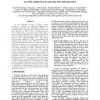Free Online Productivity Tools
i2Speak
i2Symbol
i2OCR
iTex2Img
iWeb2Print
iWeb2Shot
i2Type
iPdf2Split
iPdf2Merge
i2Bopomofo
i2Arabic
i2Style
i2Image
i2PDF
iLatex2Rtf
Sci2ools
BIBE
2001
IEEE
2001
IEEE
An XML Application For Genomic Data Interoperation
As the eXtensible Markup Language (XML) becomes a popular or standard language for exchanging data over the Internet/Web, there are a growing number of genome Web sites that make their data available in XML format. Publishing genomic data in XML format alone would not be that useful if there is a lack of development of software applications that could take advantage of the XML technology to process these XML-formatted data. This paper illustrates the usefulness of XML in representing and interoperating genomic data between two different data sources (Snyder's laboratory at Yale and SGD at Stanford). In particular, we compare the locations of transposon insertions in the yeast DNA sequences that have been identified by BLAST searches with the chromosomal locations of the yeast open reading frames (ORFs) stored in SGD. Such a comparison allows us to characterize the transposon insertions by indicating whether they fall into any ORFs (which may potentially encode proteins that posse...
| Added | 23 Aug 2010 |
| Updated | 23 Aug 2010 |
| Type | Conference |
| Year | 2001 |
| Where | BIBE |
| Authors | Kei-Hoi Cheung, Yang Liu, Anuj Kumar, Michael Snyder, Mark Gerstein, Perry L. Miller |
Comments (0)

